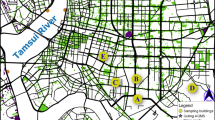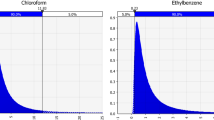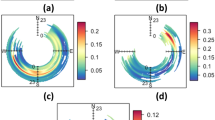Abstract
Data from the Total Exposure Assessment Methodology studies, conducted from 1980 to 1987 in New Jersey (NJ) and California (CA), and the 1990 California Indoor Exposure study were analyzed using positive matrix factorization, a receptor-oriented source apportionment model. Personal exposure and outdoor concentrations of 14 and 17 toxic volatile organic compounds (VOCs) were studied from the NJ and CA data, respectively. Analyzing both the personal exposure and outdoor concentrations made it possible to compare toxic VOCs in outdoor air and exposure resulting from personal activities. Regression analyses of the measured concentrations versus the factor scores were performed to determine the relative contribution of each factor to total exposure concentrations. Activity patterns of the NJ and CA participants were examined to determine whether reported exposures to specific sources correspond to higher estimated contributions from the factor identified with that source. For a subset of VOCs, a preliminary analysis to determine irritancy-based contributions of factors to exposures was carried out. Major source types of toxic VOCs in both NJ and CA appear to be aromatic sources resembling automobile exhaust, gasoline vapor, or environmental tobacco smoke for personal exposures, and automobile exhaust or gasoline vapors for outdoor concentrations.
This is a preview of subscription content, access via your institution
Access options
Subscribe to this journal
Receive 6 print issues and online access
$259.00 per year
only $43.17 per issue
Buy this article
- Purchase on Springer Link
- Instant access to full article PDF
Prices may be subject to local taxes which are calculated during checkout




Similar content being viewed by others
References
Antilla P, Paatero P, Tapper U, and Järvinen O, Source identification of bulk wet deposition in Finland by positive matrix factorization, Atmos Environ (1995) 29: 1705–1718
Apte MG and Daisey JM, VOCs and “Sick Building Syndrome”: application of a new statistical approach for SBS research to U.S. EPA base study data, Indoor Air (1999 177–122
Clayton CA and Perritt RL, Data base development and data analysis for California Indoor Exposure Studies. California Air Resources Board 1993 pp. A133–187
Daisey JM Mahanama KRR and Hodgson AT, Toxic volatile organic compounds in environmental tobacco smoke: emissions factors for modeling exposures of California populations. California Air Resources Board 1994 pp. A133–186
Edgerton SA Holdren MW Smith DL and Shah JJ, Inter-urban comparison of ambient volatile organic compounds concentrations in U.S. cities, J. Air Waste Manage Assoc (1989) 39: 729–732
Henry RC Lewis CW and Collins JF, Vehicle-related hydrocarbon source compositions from ambient data: the GRACE/SAFER method, Environ Sci Technol (1994) 28: 823–832
Kasanen JP Pasanen AL Pasanen P Liesivuori J Kosma VM and Alarie Y, Stereospecificity of the sensory irritation receptor for nonreactive chemicals illustrated by pinene enantiomers, Arch Toxicol (1998) 72: 514–523
Lin C, and Milford JB, Decay-adjusted chemical mass balance receptor modeling for volatile organic compounds, Atmos Environ (1994) 28: 3261–3276
Lonneman WA Kopczynski SL Darley PE and Sutterfield FD, Hydrocarbon composition of urban air pollution, Environ Sci Technol (1974) 8: 229–236
MacIntosh DL Xue J Ozkaynak H Spengler JD and Ryan PB, A population-based exposure model for benzene, J Exposure Anal Environ Epidemiol (1995) 5: 375–403
McKone T, Human exposure to volatile organic compounds in household tap water: the indoor inhalation pathway, Environ Sci Technol (1987) 21: 1194–1201
Mølhave L, Indoor air pollution due to organic gases and vapours of solvents in building materials, Environ Int (1982) 8: 117–127
Mukund R Kelly TJ and Spicer CW, Source attribution of ambient air toxic and other VOCs in Columbus, Ohio, Atmos Environ (1996) 30: 3457–3470
National Exposure Research Laboratory (NERL), USEPA, THERdbASE Exposure Assessment Software http://www.epa.gov/nerl/heasd/therd-home.htm(accessed July 5, 2000)
Office of Air Quality Planning and Standards (OAQPS), USEPA, Taking toxics out of the air: progress in setting “maximum achievable control technology” standards under the Clean Air Act. EPA/451/K-98-001 (1998
Paatero P, Least squares formulation of robust non-negative factor analysis, Chemom Intell Lab Syst (1997) 37: 15–35
Paatero P, User's guide for positive matrix factorization programs PMF2 and PMF3 (1998) ftp://rock.helsinki.fi/pub/misc/pmf/
Paatero P, and Tapper U, Positive matrix factorization: a non-negative factor model with optimal utilization of error estimates of data values, Environmetrics (1994) 5: 111–126
Pandian MD Bradford J and Behar JV, THERDBASE: total human exposure relational database. Proceedings of the EPA/AWMA Specialty Conference: Total Exposure Assessment Methodology, A New Horizon. Air & Waste Management Association, Pittsburgh, PA 1989 pp. 204–209
Pirkle JL Flegal KM Bernett JT Brody DJ Etzel RA and Maurer KR, Exposure of the U.S. population to environmental tobacco smoke, J Am Med Assoc (1996) 275: 1233–1240
Ramadan Z, Song X-H, and Hopke PK, Identification of source of Phoenix aerosol by positive matrix factorization, J Air Waste Manage Assoc (2000) 50: 1308–1320
Rappaport SM Selvin S and Waters MA, Exposures to hydrocarbon components of gasoline in the petroleum industry, Appl Ind Hyg (1987) 2: 148–154
Rosenbaum AS Axelrad DA Woodruff TJ Wei Y Ligocki MP and Cohen JP, National estimates of outdoor air toxics concentrations, J Air Waste Manage Assoc (1999) 49: 1138–1152
Samfield MM, Indoor air quality data base for organic compounds. EPA-600-R-92-025 (1992)
Scheff PA Porter JA and Doskey PV, Improvement of VOC source fingerprints for vehicles and refineries, Paper No. 91–79.5, Air & Waste Management Association (1991)
Scheff PA Wadden RA Bates BA and Aronian PF, Source fingerprints for receptor modeling of volatile organics, J Air Pollut Control Assoc (1989) 39: 469–478
Sheldon L, Clayton A, Jones B, Keever J, Perritt R, Smith D, Whitaker D, and Whitmore R, Indoor pollutant concentrations and exposures. California Air Resources Board (CARB) A833-156 1992 pp. 9.39–9.47
Singh HB Salas LJ Cantrell BK and Redmond RM, Distribution of aromatic hydrocarbons in the ambient air, Atmos Environ (1985) 19: 1911–1919
Ten Brinke J, Development of new VOC exposure metrics and their relationship to “sick building syndrome” symptoms. Lawrence Berkeley Laboratory. LBL-37652. 1995
Unified Air Toxics Website (UATW), USEPA, Unified air toxics website: the pollutants. http://www.epa.gov/ttn/uatw/(accessed June 30, 2000)
Wallace LA, The Total Exposure Assessment Methodology (TEAM) study: summary and analysis: vol. I. EPA/600/6-87/002a (1987)
Wallace LA, The Total Exposure Assessment Methodology (TEAM) study: an analysis of exposures, sources and risks associated with four volatile organic chemicals, J Am Coll Toxicol (1989) 8: 883–895
Wallace LA, Comparison of risk from outdoor and indoor exposure to toxic chemicals, Environ Health Perspect (1991) 95: 7–13
Wallace LA, Environmental exposure to benzene: an update, Environ Health Perspect (1996) 104: 1129–1135
Wallace LA Pellizari ED Hartwell T Rosenzweig M Erickson M Sparacino C and Zelon H, Personal exposure to volatile organic compounds: I. Direct measurement in breathing-zone air, drinking water, food, and exhaled breath, Environ Res (1984) 35: 293–319
Wallace LA Pellizari ED Hartwell TD Davis V Michael LC and Whitmore RW, The influence of personal activities on exposure to volatile organic compounds, Environ Res (1989) 50: 37–55
Whitby RA and Altwicker ER, Acetylene in the atmosphere: sources, representative ambient concentrations, and ratios to other hydrocarbons, Atmos Environ (1978) 12: 1289–1296
Yakovleva E Hopke PK and Wallace L, Receptor modeling assessment of Particle Total Exposure Assessment Methodology data, Environ Sci Technol (1999) 33: 3645–3652
Acknowledgements
This research was supported by U.S. EPA grant number R82-6788-010. The PMF model was used under a licensing agreement with Pentti Paatero of the University of Helsinki. We are grateful to Eileen Daly and Bill Oliver for their assistance with the statistical analysis of the data.
Although the research described in this article has been funded by the U.S. EPA, it has not been subjected to any EPA review and therefore does not necessarily reflect the views of the Agency, and no official endorsement should be inferred.
Author information
Authors and Affiliations
Corresponding author
Rights and permissions
About this article
Cite this article
ANDERSON, M., MILLER, S. & MILFORD, J. Source apportionment of exposure to toxic volatile organic compounds using positive matrix factorization. J Expo Sci Environ Epidemiol 11, 295–307 (2001). https://doi.org/10.1038/sj.jea.7500168
Received:
Accepted:
Published:
Issue Date:
DOI: https://doi.org/10.1038/sj.jea.7500168
Keywords
This article is cited by
-
The Chemistry of Intercepted Clouds in Northern Arizona during the North American Monsoon Season
Water, Air, and Soil Pollution (2009)
-
PM source apportionment and health effects: 1. Intercomparison of source apportionment results
Journal of Exposure Science & Environmental Epidemiology (2006)
-
Ambient, indoor and personal exposure relationships of volatile organic compounds in Mexico City Metropolitan Area
Journal of Exposure Science & Environmental Epidemiology (2004)



